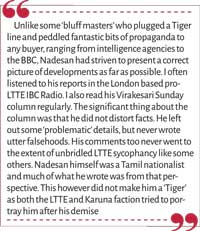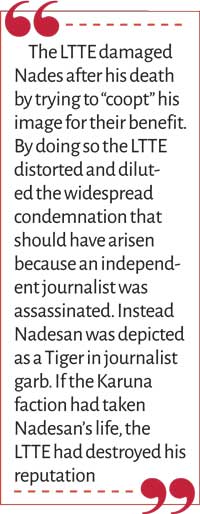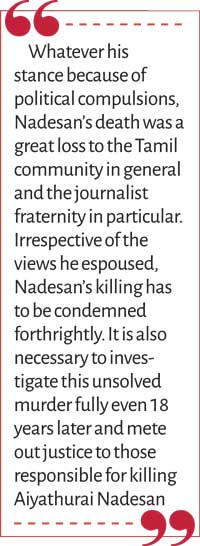Sunday Jan 11, 2026
Sunday Jan 11, 2026
Wednesday, 1 June 2022 00:40 - - {{hitsCtrl.values.hits}}

Aiyathurai Nadesan
The death of any member of the journalistic fraternity is distressing. More so when a scribe is gunned down in broad daylight by ‘unknown’ assassins for the ‘crime’ of writing something that displeased people with pretensions of power.
people with pretensions of power.
The sadness is even more acute when the journalist was someone known to you for more than 25 years and had been immensely helpful as a source of accurate news and stimulating views.
Aiyathurai Nadesan who served as Batticaloa correspondent of the Tamil daily “Virakesari” was killed in broad daylight 18 years ago in the heart of Batticaloa town. He was commemorated on Sunday 29 May at an event organised by fellow journalists in the Batticaloa Library Auditorium. A book was released in his memory.
No concrete action has been taken to investigate the murder so far. Nadesan was a friend whom I had known for over 25 years. I have written about Nadesan’s assassination, when he was killed. I shall however re-visit Nadesan’s killing with the intention of drawing attention to an unsolved murder of a journalist and friend.
Aiyathurai Nadesan
Aiyathurai Nadesan was shot dead on 31 May 2004 at about 9:35 a.m. in Batticaloa town. He was riding his motorcycle to work when the assailants shot him dead at point blank range on Boundary Road. Leaving his home on Lake Road, Batticaloa at 9:20 a.m. Nadesan had followed his usual practice of picking up his Virakesari copy from the boutique next to the Virakesari office on Central Road.
Nadesan, though a journalist worked as an income tax assessor, too. He was going along Boundary Road and nearing his Bar Road office, when the assassins struck. Two men on a blue motor cycle — both wearing helmets — were the killers. At least four shots were fired at point blank range from a 9 mm. Two hit Nadesan’s shoulder and chest. One struck his hand. The killers whizzed away. There were many witnesses but none came forward to give evidence to the Police.
Nadesan’s bike knocked against a concrete lamp post and he was thrown off. Nadesan fell into a drain. The fall had resulted in his ribs getting fractured. He lay bleeding about 200 yards away from his workplace on Bar Road and died at the spot after a while.
The Bar Road-Boundary Road area is a very busy place in the morning. Many people saw Nadesan lying in the drain for a long time. Yet no one came to his aid. Such was the state of fear in Batticaloa during those times, that people were scared to display even the most basic human tendencies at times like these.
Prabhakaran-Karuna
The people of Batticaloa were in the grip of two contending “terrorist” forces at that time. The clash for supremacy between the mainstream Liberation Tigers of Tamil Eelam (LTTE) and the Batticaloa- Amparai dissident faction led by ex-tiger eastern commander Vinayagamoorthy Muraleetharan alias “Col” Karuna had led to a situation where lives were being snuffed out without restraint. People were afraid to talk freely as they did not know who supported Prabhakaran and who supported Karuna.
Amparai dissident faction led by ex-tiger eastern commander Vinayagamoorthy Muraleetharan alias “Col” Karuna had led to a situation where lives were being snuffed out without restraint. People were afraid to talk freely as they did not know who supported Prabhakaran and who supported Karuna.
It was left to a fellow journalist, Thurairatnam and the then TELO Batticaloa Organiser Indrakumar alias Prasanna to go to the spot, examine the body of the lifeless Nadesan, and alert the authorities. The then Batticaloa Magistrate M. Ajmeer went to the place at about 11 a.m. and ordered that the body be taken to the hospital and handed over to the family after an inquest. This then was the sad tale of Nadesan’s demise.
Though a resident of Batticaloa for nearly 20 years, Nadesan was not an easterner. His wife Gowri was from Batticaloa. Nadesan however had adopted Batticaloa as his native place and integrated himself with the region.
He spotlighted the problems facing the people aptly. He was easily one of the best Tamil media journalists in the country at the time of his death.
Hailed From Nelliaddy
The scribe who was 49 at the time of his demise, hailed from Nelliaddy. Nadesan’s father Aiyathurai was a Cooperative Inspector with an impeccable reputation for honesty and integrity. Nadesan’s house was down Chettitharai Lane between Nelliaddy Central College and the Vathiri Road junction.
Conforming to the practice adopted by many artistes and writers of adding their village name as a prefix Nadesan too used the condensed version of Nelliaddy “Nellai” before his name. It was as “Nellai Nades” that he wrote articles, short stories and poems during his school and undergraduate days.
When I first met him in 1977 while working at the Virakesari, he was known as Nellai Nades. Nadesan used to drop in frequently to meet the then Virakesari News Editor S. Nadarajah who was also from Anaipanthy in Nelliaddy. Later as a journalist, he used the by-line G. Nadesan. The ‘G’ denoted his wife Gowri.
Anaipanthy in Nelliaddy. Later as a journalist, he used the by-line G. Nadesan. The ‘G’ denoted his wife Gowri.
Technically Nadesan was not a full-time journalist. He was an Income Tax Assessor by profession. He was a part-time journalist but in practical terms the part-time was full-time. He was the Batticaloa correspondent for the Virakesari and also for Shakthi TV and radio. He also worked for the London based International Broadcasting Corporation. Given the volume and scope of his journalism, one could safely say that Nadesan was far more productive than many full-time journalists in the Tamil media those days.
After obtaining a degree in Business Administration, Nadesan became a teacher for a while. Later he joined the Inland Revenue Department as a clerk and subsequently became an Assessor. He used to write articles as a freelance contributor to the Virakesari under his pen name “Nellai Nades.”
“Virakesari” Batticaloa correspondent
He later became the Virakesari’s Batticaloa correspondent. Nadesan married in Batticaloa and settled down there. The “Nellai” gave way to ‘G’ (Gowri). They had four children, two boys and two girls.
The news of a Virakesari Batticaloa correspondent being killed on the line of duty was and is of poignant impact to me. One of the happiest and challenging periods of life for me as a journalist on the Virakesari was when I worked as Batticaloa staff correspondent for three months in 1977. (June and Nov-Dec). The Virakesari then had a brilliant journalist, V.S. Kathirgamathamby as Batticaloa correspondent. I had to replace him twice on a temporary basis then.
After Kathirgamathamby retired another close friend, Nithianandan became Batticaloa correspondent of the Virakesari. Nithy, an ardent Tamil nationalist got too involved with the LTTE. During the time of the IPKF, Nithy was viciously stabbed by some members of the pro-IPKF group, the EPRLF. Then Indian envoy J.N. Dixit arranged for immediate air lifting of Nithy to Colombo for urgent medical treatment at the request of Nithy’s journalist friends then.
After recovering Nithy worked in the Colombo Virakesari office. When the Indian army left he returned to Batticaloa and joined the LTTE as a full-time member. He was later ambushed and killed by the Sri Lankan Army. Nadesan became the acting and later permanent Batticaloa correspondent after Nithy.
“Col” Karuna’s LTTE faction
Though the Police said that they had no idea who Nadesan’s killers were, the people of Batticaloa knew fully well, who they were. It was an open secret in Batticaloa that the killing was carried out by members of renegade leader “Col” Karuna’s LTTE faction known as “Batticaloa-Amparai Liberation Tigers.”
fully well, who they were. It was an open secret in Batticaloa that the killing was carried out by members of renegade leader “Col” Karuna’s LTTE faction known as “Batticaloa-Amparai Liberation Tigers.”
Subsequently they formed a new politico-military organisation called “Tamil Makkal Viduthalai Pulikal” (Tamil People’s Liberation Tigers). After killing Nadesan the Karuna faction of the LTTE tried to justify it by accusing him of being a Prabhakaran loyalist. The mainstream LTTE on the other hand tried to derive propaganda mileage by claiming him as one of their own.
Though a Tamil nationalist in the ‘70s and ‘80s of the last century, Nadesan was more of a leftist than an ethno-populist. When Tamil militancy grew, Nades was more aligned with the Eelam People’s Revolutionary Liberation Front (EPRLF) than the LTTE. Nades was closely associated with former EPRLF Northeastern Chief Minister Annamalai Varadarajaperumal.
N-E PC Information Officer
Nades and Varathan had been contemporaries at the Jaffna University and had also taught together at a Nelliaddy tuition centre later. When the northeast provincial council was formed Nadesan got himself seconded from government service and got appointed as Varatharajaperumal’s press officer. I think his official title was ‘Information Officer.’ Ironically Nades was also an unofficial censor when the North-Eastern Provincial Council was in existence.
Nadesan discharged his duties efficiently. With the LTTE threatening the Tamil media on the one hand, it was a formidable task to project the northeast provincial council activities in a favourable light. Nades did so, often exerting ‘pressure’ on editors and management personnel. One editor told me how Nades would often utter veiled threats in order to get pro-EPRLF news published.
When the council was dissolved in 1990 and the bulk of EPRLF including Perumal fled from Sri Lanka, Nades did not follow suit. He opted to take his chances with the LTTE rather than fleeing the country to India. Nades was arrested as a ‘traitor’ by the LTTE and detained in a bunker prison. He was subjected to physical and mental torture. Nadesan’s stand was that he was only an employee of the Northeast Provincial Council, doing his duty.
Finally, Nadesan’s brother Sivanathan, a prosperous mill owner had to pay a hefty donation to secure his release. The LTTE that detained Nadesan as a traitor may very well have killed him in captivity like many others if not for the money being paid. After Nadesan was killed the same LTTE started showering patriotic titles and organising condolence meetings and protest demonstrations in his memory.
Source of information
As a journalist living in Canada and writing about Sri Lanka, I kept in touch with Nadesan on the phone for several years. He was a reliable source of information about events in the east. Though he espoused a strong Tamil nationalist line he was by no means an LTTE acolyte.
espoused a strong Tamil nationalist line he was by no means an LTTE acolyte.
Nevertheless he had to adopt a ‘safe’ course. Often he would tell me of happenings which he himself could never report in Sri Lanka. What he wrote in print and what he said on the phone were sometimes different. “We can’t write the whole truth. At least you do something,” he would say.
This was a tremendous existential problem encountered by Tamil journalists in the northeast. Having worked as provincial correspondent for the Virakesari both in Jaffna and in Batticaloa, I know only too well the pressures on the outstation correspondent. Later on, the war situation imposed an immense burden on these journalists. Even the brief interludes of fragile peace during the years of war did not bring any relief to the scribes in the northeast.
Scribes in the north-east
The scribes living in the north-east had to face indirect LTTE pressure in those days. There was also pressure from the armed forces and even other non-Tiger Tamil groups. However, the biggest threat was the LTTE and almost all Tamil newspapers in Sri Lanka toed a pro-Tiger line then.
While Tamil nationalism is the staple sustenance of the Tamil media, the LTTE factor brought about a qualitatively destructive change then. Against this backdrop one would hesitate to judge journalists in Nadesan’s position without having walked in their shoes.
Unlike some ‘bluff masters’ who plugged a Tiger line and peddled fantastic bits of propaganda to any buyer, ranging from intelligence agencies to the BBC, Nadesan had striven to present a correct picture of developments as far as possible. I often listened to his reports in the London based pro-LTTE IBC Radio. I also read his Virakesari Sunday column regularly.
The significant thing about the column was that he did not distort facts. He left out some ‘problematic’ details, but never wrote utter falsehoods. His comments too never went to the extent of unbridled LTTE sycophancy like some others. Nadesan himself was a Tamil nationalist and much of what he wrote was from that perspective. This however did not make him a ‘Tiger’ as both the LTTE and Karuna faction tried to portray him after his demise
The pro-Karuna website “Neruppu” which scooped the Nadesan killing described Nades as a “Wannippulippathirigaiyaalar” (journalist of the Wanni tigers). Tarnishing a dead man’s name to justify a dastardly killing is a typical Tiger trait. The Karuna faction was no doubt adhering to its roots in this matter.
LTTE mourning Nadesan’s death
The Prabhakaran-led LTTE began capitalising on Nadesan’s death. The Tigers organised a worldwide campaign condemning and mourning Nadesan’s death to obtain political mileage. A team of Tigers led by Senathi went to the funeral house and wrapped a Tiger flag around the body. Nadesan’s sister objected. The flag was removed.
Later Nadesan’s body was taken to the Northern Province for cremation at the Aalankatti cemetery in Vathiri. The LTTE took over the funeral arrangements. Homage ceremonies were organised in Vavuniya, Kilinochchi, Jaffna and Karaveddy. Nadesan’s body, now wrapped in a Tiger flag lay in state for people to pay their respects. The LTTE orchestrated large crowds of mourners. Leading LTTE figures spoke at the various ceremonies as well as the funeral itself. The LTTE organised a massive demonstration and hartal in the northeast to condemn the killing. Almost all the Tiger media started lamenting Nadesan’s loss ad nauseam.
Tiger media organs devoted much time and space to Nadesan. In typical Tiger fashion, fund raising in his memory commenced overseas. Fund raising to the LTTE was like a fire hydrant to a mongrel. The LTTE Leader Prabhakaran conferred upon Nadesan the posthumous title “Naatuppattraalar” (Patriot). By this action of dubbing Nadesan a patriot the LTTE tried to show the world that he was one of theirs.
Sadly all these efforts helped to strengthen the impression that Nadesan was a Tiger scribe. The truth however was different. This typical LTTE deception only helped to reinforce the Karuna Group charge that Nades was a Tiger associate.
The LTTE damaged Nades after his death by trying to “coopt” his image for their benefit. By doing so the LTTE distorted and diluted the widespread condemnation that should have arisen because an independent journalist was assassinated. Instead Nadesan was depicted as a Tiger in journalist garb. If the Karuna faction had taken Nadesan’s life, the LTTE had destroyed his reputation.
Whatever his faults or deficiencies, there is no doubt that “Nellai” Nades was mourning Nadesan’s death and clever craftsman. Most of his articles were well researched and had a lot of facts and figures. I have at times relied on his articles to get data and statistics.
Must investigate this murder
Whatever his stance because of political compulsions, Nadesan’s death was a great loss to the Tamil community in general and the journalist fraternity in particular. Irrespective of the views he espoused, Nadesan’s killing has to be condemned forthrightly. It is also necessary to investigate this unsolved murder fully even 18 years later and mete out justice to those responsible for killing Aiyathurai Nadesan.
(This is a modified version of an article written earlier.)
(The writer can be reached at [email protected].)